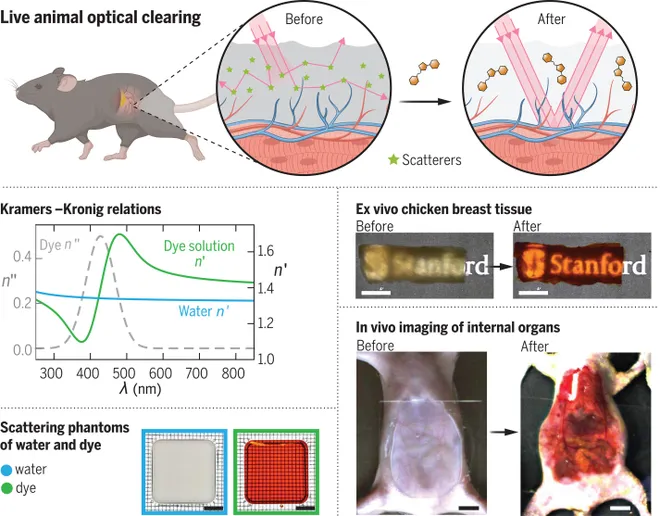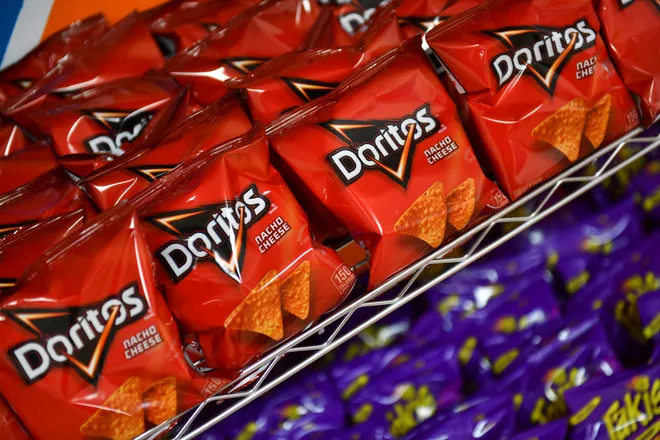Dye in Doritos used in experiment that, like a 'magic trick,' created see-through mice
Doritos are a revered snack for many. Now, scientists have found one of the ingredients in the triangle-shaped tasty tortilla chips has a superpower – it can make the skin of mice transparent.
Researchers at Stanford University detail, in the Sept. 6 issue of the journal Science, how they were able to see through the skin of live mice by applying a mixture of water and tartrazine, a bright yellow-orange food coloring used in Doritos and other foods, drugs, and cosmetics.
The experiments arose from the quest for better methods to see tissue and organs within the body. The researchers chose tartrazine because the dye's molecules absorb blue and ultraviolet light, which makes it easier for light to pass through the mouse skin.
“For those who understand the fundamental physics behind this, it makes sense; but if you aren’t familiar with it, it looks like a magic trick,” said Zihao Ou, the lead author of the study who is now an assistant professor of physics at The University of Texas at Dallas, in a description of the research on the university's website.
Are cellphones a risk for cancer?:Not likely, report says.
The Doritos effect: Snack ingredient yields invisible mouse
After testing the dye on mice tissue samples and raw chicken breast, the researchers rubbed the dye and water solution onto the skulls and abdomens of the mice. As the dye was absorbed, within a few minutes they could see "the skin, muscle, and connective tissues transparent in live rodents," the researchers write in the journal article.
Once researchers wash off the dye, the mice lost their translucency and the dye is excreted through urine, according to the university site's description of the study. “It’s important that the dye is biocompatible – it’s safe for living organisms,” Ou said. “In addition, it’s very inexpensive and efficient; we don’t need very much of it to work.”

Before you start slathering yourself in Doritos – the coloring is used in several Doritos flavors including Nacho Cheese, Cool Ranch and Flaming Hot Nacho – tartrazine won't necessarily give humans a cloak of invisibility á la Harry Potter.
That's because human skin is about 10 times thicker than a mouse and it's not sure how much of the dye – or how it would be administered – is needed to work in humans, Ou said.
Researchers plan to continue investigating that and experiment with other substances that could outperform tartrazine.
“Optical equipment, like the microscope, is not directly used to study live humans or animals because light can’t go through living tissue," Ou said. "But now that we can make tissue transparent, it will allow us to look at more detailed dynamics. It will completely revolutionize existing optical research in biology.”


In an accompanying editorial article in the journal, biophotonics researcher Christopher Rowlands and experimental optical physicist Jon Gorecki, both at the Imperial College London, compare the finding to H.G. Wells' 1897 novel "The Invisible Man."
Combined with other techniques, the tartrazine development could result in "permitting deeper imaging than either could alone," they wrote.
Follow Mike Snider on X and Threads: @mikesnider & mikegsnider.
What's everyone talking about? Sign up for our trending newsletter to get the latest news of the day
Disclaimer: The copyright of this article belongs to the original author. Reposting this article is solely for the purpose of information dissemination and does not constitute any investment advice. If there is any infringement, please contact us immediately. We will make corrections or deletions as necessary. Thank you.




